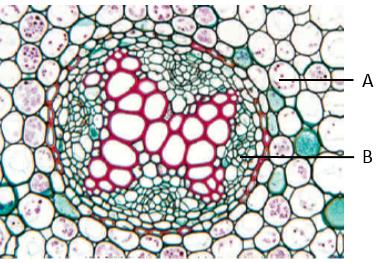?

Figure 27.5
Use the figure above to answer the following question.
The letter "A" in the accompanying figure represents ____.
A. pericycle
B. endodermis
C. primary xylem
D. root cortex
E. primary phloem
Answer: D
You might also like to view...
What is a likely explanation for why nothing happened in your experiment?
Sometimes the most practical way to do an experiment is not to perform it in an animal, but to look at cell responses in culture. Cells from mice, humans, and other mammals have been used to establish cell culture lines that have been very important for research. You are studying a novel water-soluble mouse hormone. You know cell culture can be a practical model to reveal protein function, so you apply the hormone to yeast cells, but nothing happens. A. Yeast have a cell wall, so the molecule cannot pass through the cell membrane as it would in mice. B. Water-soluble hormones are lipids, not proteins. C. You need to apply the hormone in large amounts to see an effect. D. Yeast may lack the receptor required for the hormone to act. Clarify Question What is the key concept addressed by the question? What type of thinking is required? Gather Content What do you already know about hormones? What other information is related to the question? Choose Answer Given what you now know, what information is most likely to produce the correct answer? Reflect on Process Did your problem-solving process lead you to the correct answer? If not, where did the process break down or lead you astray? How can you revise your approach to produce a more desirable result?
A type II diabetic ____
a. requires insulin injections b. produces too much glucagon c. is usually under-weight d. is insulin resistant e. is usually hypoglycemic
The overuse of antibiotics has led to a form of antibiotic resistant tuberculosis. This has occurred as a result of:
a. directional selection within the bacterial population. b. stabilizing selection within the bacterial population. c. disruptive selection within the bacterial population. d. balanced polymorphism within the bacterial population. e. a heterozygote advantage within the bacterial population.
In the equation 2 H2 + O2 ? 2 H2O,
A) H2, O2, and H2O are all compounds. B) H2, O2, and H2O are all elements. C) only H2O is a compound. D) only H2 and O2 are compounds.